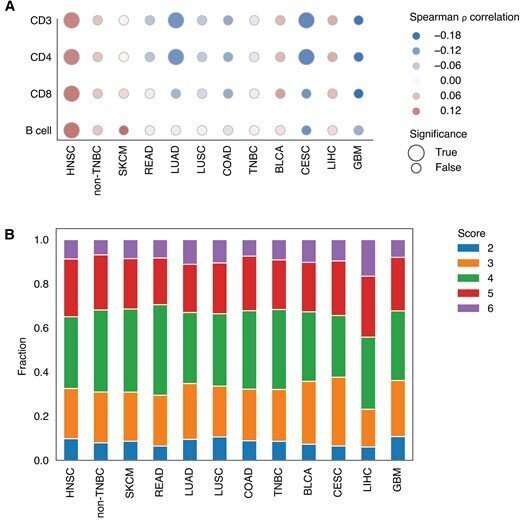This article has been reviewed according to Science X's editorial process and policies. Editors have highlighted the following attributes while ensuring the content's credibility:
fact-checked
peer-reviewed publication
trusted source
proofread
Researchers identify a potential new target for head and neck cancer immunotherapy

Researchers at University of California San Diego School of Medicine and Moores Cancer Center at UC San Diego Health have identified a strong association between the product of a gene expressed in most cancers, including the most common type of head and neck cancer, and elevated levels of white blood cells that produce antibodies within tumors.
The findings, published in the March 10, 2023 issue of PNAS Nexus, suggest a potential new target and approach for cancer immunotherapies that have thus far produced mixed results for certain head and neck cancers.
Telomerase reverse transcriptase (TERT) is an antigen abundantly produced in roughly 85% of tumor cells. Antigens are toxins or other substances that provoke an immune response against that substance. This is especially true with TERT in cancer patients.
But the effects of TERT expression on regulation of adaptive immunity within tumors is not understood. In the new study, co-senior study author Maurizio Zanetti, MD, professor of medicine at UC San Diego School of Medicine and head of the Laboratory of Immunology at UC San Diego Moores Cancer Center, and colleagues used RNA sequencing data from The Cancer Genome Atlas.
"Our data emerged through targeted computational reanalysis of The Cancer Genome Atlas, a valuable public tumor sequencing dataset, guided by core principles of immunology," said co-senior author Hannah Carter, Ph.D., associate professor at UC San Diego School of Medicine, said.
Specifically, Zanetti, Carter and their collaborators looked at 11 solid tumor types to investigate potential interactions between TERT expression and B and T cells that have infiltrated the tumor microenvironment.
B cells are immune response cells that produce antibodies to antigens, from bacteria and viruses to toxins. T cells are immune cells that target and destroy cells in the body that have been taken over by antigens or become cancerous. But B cells also present antigens to T cells triggering their activation in the process.
The researchers found a positive correlation between TERT expression and B and T cells in four cancer types, with the strongest association in head and neck squamous cell carcinoma, a condition that develops in the mucous membranes of the mouth, nose and throat.
They found that patients in which this association was found are linked to more favorable clinical outcomes. The findings, said Zanetti, suggest the de novo formation of lymphoid structures intra-tumor by B and T lymphocytes with TERT as potential connecting antigen.
Head and neck squamous cell carcinoma (HNSCC) is the sixth most common malignancy. It accounts for 90% of all head and neck cancers. The primary causes of the disease are long-term tobacco use, alcohol consumption and infection by high-risk types of the human papillomavirus.
In the United States, there are approximately 66,000 new head and neck cancer diagnoses annually, and 15,000 deaths. HNSCC mortality is high. Roughly 50 to 60% of patients die within a year of diagnosis; the overall five-year survival rate (patients alive five years after diagnosis) is 50%.
Treatment of HNSCC tumors that cannot be removed through surgery consists of chemotherapy, radiation and immune checkpoint therapy, though only a small fraction of patients benefit from the immune checkpoint treatment. Zanetti said the new findings point to potentially novel ways to treat HNSCC, particularly in patients at higher risk for worse outcomes.
"Cancer immunotherapy is about treating a patient by leveraging their own immune system to fight the malignancy. Ideally, one should reinforce mechanisms already in place in patients," Zanetti said.
"The current emphasis is on neoantigens (proteins that form on cancer cells when certain mutations occur in tumor DNA) and immune checkpoint inhibitors (drugs such as monoclonal antibodies) that target and block actions that help shield cancer cells from attack by T cells. But these therapies only partially effective and in some types of cancer only. Our findings provide evidence that high TERT expression is a key signal that generates high levels of B and T cells intra-tumor, suggesting a new way to develop intra-tumor immunotherapies to reinforce anti-tumor immunity already in place."
Co-authors include: Su Xian, Magalie Dosset and Andrea Castro, all at UC San Diego.
More information: Su Xian et al, Transcriptional analysis links B cells and TERT expression to favorable prognosis in head and neck cancer, PNAS Nexus (2023). DOI: 10.1093/pnasnexus/pgad046



















